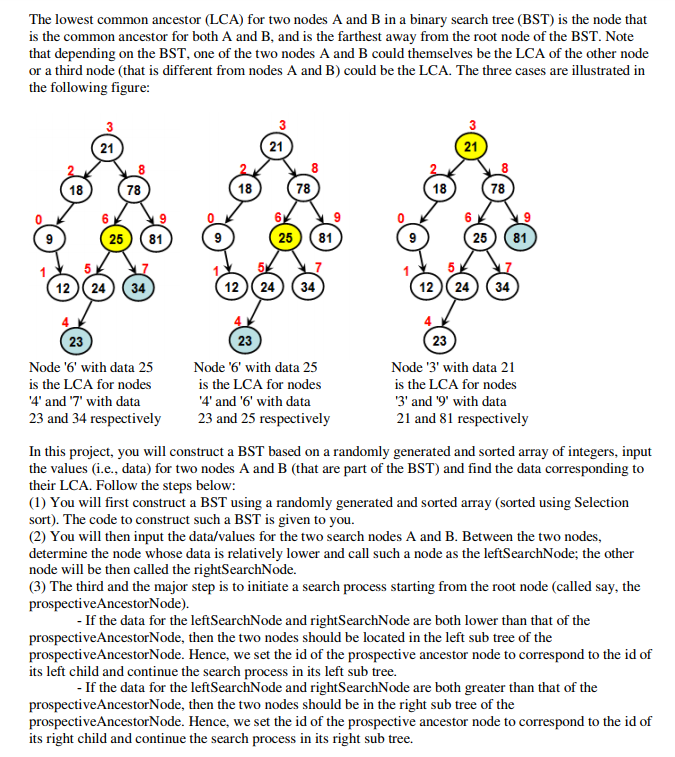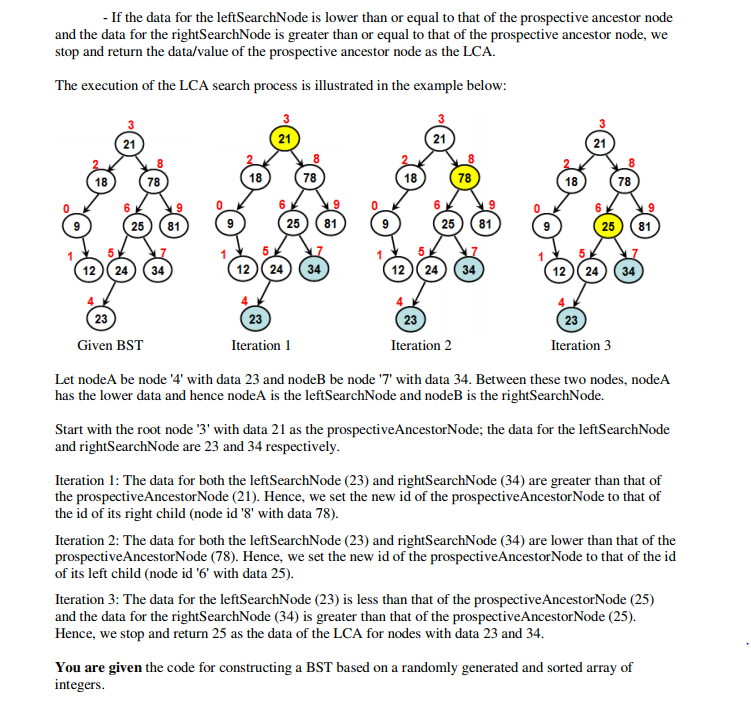Question
#include #include #include using namespace std; class BTNode{ private: int nodeid; int data; int levelNum; BTNode* leftChildPtr; BTNode* rightChildPtr; public: BTNode(){} void setNodeId(int id){ nodeid


#include
#include
#include
using namespace std;
class BTNode{
private:
int nodeid;
int data;
int levelNum;
BTNode* leftChildPtr;
BTNode* rightChildPtr;
public:
BTNode(){}
void setNodeId(int id){
nodeid = id;
}
int getNodeId(){
return nodeid;
}
void setData(int d){
data = d;
}
int getData(){
return data;
}
void setLevelNum(int level){
levelNum = level;
}
int getLevelNum(){
return levelNum;
}
void setLeftChildPtr(BTNode* ptr){
leftChildPtr = ptr;
}
void setRightChildPtr(BTNode* ptr){
rightChildPtr = ptr;
}
BTNode* getLeftChildPtr(){
return leftChildPtr;
}
BTNode* getRightChildPtr(){
return rightChildPtr;
}
int getLeftChildID(){
if (leftChildPtr == 0)
return -1;
return leftChildPtr->getNodeId();
}
int getRightChildID(){
if (rightChildPtr == 0)
return -1;
return rightChildPtr->getNodeId();
}
};
class BinarySearchTree{
private:
int numNodes;
BTNode* arrayOfBTNodes;
int rootNodeID;
public:
BinarySearchTree(int n){
numNodes = n;
arrayOfBTNodes = new BTNode[numNodes];
for (int index = 0; index
arrayOfBTNodes[index].setNodeId(index);
arrayOfBTNodes[index].setLeftChildPtr(0);
arrayOfBTNodes[index].setRightChildPtr(0);
arrayOfBTNodes[index].setLevelNum(-1);
}
}
void setLeftLink(int upstreamNodeID, int downstreamNodeID){
arrayOfBTNodes[upstreamNodeID].setLeftChildPtr(&arrayOfBTNodes[downstreamNodeID]);
}
void setRightLink(int upstreamNodeID, int downstreamNodeID){
arrayOfBTNodes[upstreamNodeID].setRightChildPtr(&arrayOfBTNodes[downstreamNodeID]);
}
void constructBSTree(int *array){
int leftIndex = 0;
int rightIndex = numNodes-1;
int middleIndex = (leftIndex + rightIndex)/2;
rootNodeID = middleIndex;
arrayOfBTNodes[middleIndex].setData(array[middleIndex]);
ChainNodes(array, middleIndex, leftIndex, rightIndex);
}
void ChainNodes(int* array, int middleIndex, int leftIndex, int rightIndex){
if (leftIndex
int rootIDLeftSubtree = (leftIndex + middleIndex-1)/2;
setLeftLink(middleIndex, rootIDLeftSubtree);
arrayOfBTNodes[rootIDLeftSubtree].setData(array[rootIDLeftSubtree]);
ChainNodes(array, rootIDLeftSubtree, leftIndex, middleIndex-1);
}
if (rightIndex > middleIndex){
int rootIDRightSubtree = (rightIndex + middleIndex + 1)/2;
setRightLink(middleIndex, rootIDRightSubtree);
arrayOfBTNodes[rootIDRightSubtree].setData(array[rootIDRightSubtree]);
ChainNodes(array, rootIDRightSubtree, middleIndex+1, rightIndex);
}
}
void printLeafNodes(){
for (int id = 0; id
if (arrayOfBTNodes[id].getLeftChildPtr() == 0 && arrayOfBTNodes[id].getRightChildPtr() == 0)
cout
}
cout
}
void InOrderTraversal(int nodeid){
if (nodeid == -1)
return;
InOrderTraversal(arrayOfBTNodes[nodeid].getLeftChildID());
cout
InOrderTraversal(arrayOfBTNodes[nodeid].getRightChildID());
}
void PrintInOrderTraversal(){
InOrderTraversal(rootNodeID);
cout
}
};
void selectionSort(int *array, int arraySize){
for (int iterationNum = 0; iterationNum
int minIndex = iterationNum;
for (int j = iterationNum+1; j
if (array[j]
minIndex = j;
}
// swap array[minIndex] with array[iterationNum]
int temp = array[minIndex];
array[minIndex] = array[iterationNum];
array[iterationNum] = temp;
}
}
int main(){
int numElements;
cout
cin >> numElements;
int *array = new int[numElements];
int maxValue;
cout
cin >> maxValue;
srand(time(NULL));
cout
for (int index = 0; index
array[index] = rand() % maxValue;
cout
}
cout
selectionSort(array, numElements);
BinarySearchTree bsTree(numElements);
bsTree.constructBSTree(array);
cout
bsTree.PrintInOrderTraversal();
cout
bsTree.printLeafNodes();
return 0;
}
What to submit: The complete code (in a word document) with the following additions to the given code. (1) An enhanced main function that inputs two integers, corresponding to the data for nodeA and nodeB, and decides which of the two is the leftSearchNode and rightSearchNode. (2) A member function findLCA(...) implemented in the class BinarySearchTree, and is called with the leftSearchNode and rightSearchNode as the two arguments. The findLCA function should implement the procedure described above and return the data corresponding to the LCA. Test your code with an array of at least 15 integers. Capture the execution of the code and include as a screenshot (of the contents of the array and the LCA).
PLEASE CODE IN C++ AND MAKE IT COPYABLE. PLEASE ANSWER THE QUESTION IN ITS ENTIRETY!!
The lowest common ancestor (LCA) for two nodes A and B in a binary search tree (BST) is the node that is the common ancestor for both A and B, and is the farthest away from the root node of the BST. Note that depending on the BST, one of the two nodes A and B could themselves be the LCA of the other node or a third node (that is different from nodes A and B) could be the LCA. The three cases are illustrated in the following figure: 21 21 21 78 18 78 18 78 25) (81 25 (81 25 81 122434 122434 122434 23 23 23 Node '6' with data 25 is the LCA for nodes 4' and '7" with data 23 and 34 respectively Node '6' with data 25 is the LCA for nodes 4' and '6' with data 23 and 25 respectively Node '3' with data 21 is the LCA for nodes 3' and 9' with data 21 and 81 respectively In this project, you will construct a BST based on a randomly generated and sorted array of integers, input the values (i.e., data) for two nodes A and B (that are part of the BST) and find the data corresponding to their LCA. Follow the steps below: (1) You will first construct a BST using a randomly generated and sorted array (sorted using Selection sort). The code to construct such a BST is given to you. (2) You will then input the data/values for the two search nodes A and B. Between the two nodes, determine the node whose data is relatively lower and call such a node as the leftSearchNode; the other node will be then called the rightSearchNode. (3) The third and the major step is to initiate a search process starting from the root node (called say, the prospectiveAncestorNode). If the data for the leftSearchNode and rightSearchNode are both lower than that of the prospectiveAncestorNode, then the two nodes should be located in the left sub tree of the prospectiveAncestorNode. Hence, we set the id of the prospective ancestor node to correspond to the id of its left child and continue the search process in its I eft sub tree. If the data for the leftSearchNode and rightSearchNode are both greater than that of the prospectiveAncestorNode, then the two nodes should be in the right sub tree of the prospectiveAncestorNode. Hence, we set the id of the prospective ancestor node to correspond to the id of its right child and continue the search p rocess in its right sub treeStep by Step Solution
There are 3 Steps involved in it
Step: 1

Get Instant Access to Expert-Tailored Solutions
See step-by-step solutions with expert insights and AI powered tools for academic success
Step: 2

Step: 3

Ace Your Homework with AI
Get the answers you need in no time with our AI-driven, step-by-step assistance
Get Started


